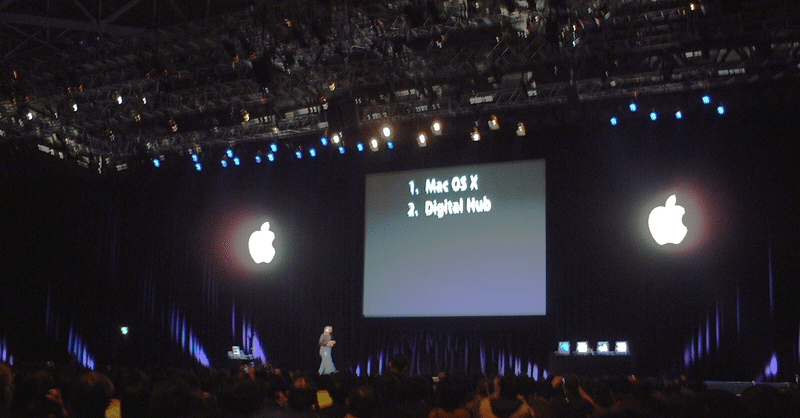
もしSteve JobsがApple Vision Proを発表したら?
こんにちは、すけろくです。
先日、Appleから革新的な空間コンピューティングデバイス、Apple Vision Proが発表されました。ここ数年のAppleの発表の中でもかなり攻めた、野心的な製品になっていると感じます。
もしJobsが生きていて、この製品の発表をしたら、どのようなものになっていたでしょうか?
今回は、2007年にSteve Jobsが行った有名なiPhoneの製品発表プレゼンをもとに、Vision Proの発表スピーチ原稿を作成してみました。
スピーチ原稿を読む前に、是非オリジナルのものを読んでみてください。
英語版
A product comes along that changes everything and Apple has been – well, first of all, one’s very fortunate if you get to work on just one of these in your career. Apple has been very fortunate. It’s been able to introduce a few of these into the world.
1984 – we introduced the Macintosh. It didn’t just change Apple. It changed the whole computer industry.
In 2001, we introduced the first iPod. And it didn’t just change the way we all listen to music, it changed the entire music industry.
In 2007, we introduced the iPhone. And it didn’t just change the way we communicate, it changed the entire mobile industry.
Well, today we’re introducing three revolutionary products of this class. The first one is a powerful iPhone with advanced capabilities. The second is a revolutionary MacBook with cutting-edge technology. And the third is a breakthrough AirPods with immersive sound experience.
So, three things: a powerful iPhone, a revolutionary MacBook, and a breakthrough AirPods. An iPhone, a MacBook, and an AirPods. An iPhone, a MacBook… are you getting it? These are not three separate devices, this is one device, and we are calling it Vision Pro. Today, Apple is going to reinvent the computing, and here it is.
No, actually here it is, but we’re going to leave it there for now.
So, before we get into it, let me talk about a category of things. The most advanced devices are called VR/AR devices, so they say. And they typically combine a display plus some interaction capability, plus they say it’s the Internet. It’s sort of the baby Internet into one device, and they all have these little plastic controllers on them. And the problem is that they’re not so immersive and they’re not so easy to use, and so if you kind of make a Business School 101 graph of the immersive axis and the easy-to-use axis, devices, regular VR/AR devices are right there, they’re not so immersive, and they’re not so easy to use.
But advanced VR/AR devices are definitely a little more immersive, but they actually are harder to use. They’re really complicated. Just for the basic stuff people have a hard time figuring out how to use them. Well, we don’t want to do either one of these things. What we want to do is make a leapfrog product that is way more immersive than any VR/AR device has ever been and super-easy to use. This is what Vision Pro is.
So, we’re going to reinvent the computing. Now, we’re going to start with a revolutionary user interface. It is the result of years of research and development, and of course, it’s an interplay of hardware and software.
Now, why do we need a revolutionary user interface? Let's take a look at the current VR/AR devices, right? Meta Quest, the HTC Vive, Samsung Gear VR, Google Daydream — the usual suspects. And, what’s wrong with their user interfaces? Well, the issue lies in their reliance on physical controllers. These devices all come with controllers that are always present, whether or not you need them. And they all have these control buttons that are fixed in plastic and are the same for every application. However, the reality is that every application has unique needs and would benefit from a slightly different user interface, a slightly optimized set of controls, just for it.
And what happens if you think of a great idea six months from now? You can’t run around and add a button to these things. They’re already shipped. So what do you do? It doesn’t work because the buttons and the controls can’t change. They can’t change for each application, and they can’t change down the road if you think of another great idea you want to add to this product.
Well, how do you solve this? Hmm. It turns out, we have solved it. We solved it in smartphones 15 years ago. We solved it with a touch screen that could display anything we want. Put any user interface up. And a pointing device. We solved it with the finger. We solved this problem. So how are we going to take this to a VR/AR device? What we’re going to do is get rid of all these buttons and just make a giant screen. A giant screen.
But we're not stopping there. We're going beyond the screen, beyond the physical constraints of a device. We're introducing a new way to interact with your digital world, not with a controller, not with a touch screen, but with your own hands and voice in a 3D space. We're introducing a new form of computing, spatial computing, and we're calling it Vision Pro. Today, Apple is going to reinvent computing.
日本語訳
ある製品が登場して、すべてを変える――それがAppleが行ってきたことです。まず、キャリアの中でこれらのうちのひとつに携わることができれば非常に幸運です。Appleは非常に幸運でした。いくつかのこれらの製品を世に送り出すことができました。
1984年、Macintoshを紹介しました。それは単にAppleを変えたのではありませんでした。それはコンピューター産業全体を変えました。
2001年、最初のiPodを紹介しました。それは単に私たちが音楽を聴く方法を変えただけでなく、音楽産業全体を変えました。
2007年、iPhoneを紹介しました。それは単に私たちのコミュニケーション方法を変えただけでなく、モバイル産業全体を変えました。
さて、今日私たちはこのクラスの革新的な製品を3つ紹介します。最初は高性能な機能を備えたiPhoneです。2つ目は革新的なテクノロジーを搭載したMacBookです。そして3つ目は没入型の音響体験を提供する画期的なAirPodsです。
つまり、3つのものです。高性能なiPhone、革新的なMacBook、そして画期的なAirPodsです。iPhone、MacBook、AirPods。iPhone、MacBook... 分かりますか?これらは3つの別々のデバイスではなく、1つのデバイスであり、私たちはそれをVision Proと呼んでいます。今日、Appleはコンピューティングを再発明します。それがこちらです。
いえ、実際にはこちらですが、とりあえず置いておきます。
では、それに入る前に、あるカテゴリについて話しましょう。最も先進的なデバイスはVR/ARデバイスと呼ばれるものです、そう言われています。そして、通常、ディスプレイと何らかの操作機能、そしてインターネットだと言われています。それはまるでベビーインターネットのようなもので、すべてのデバイスにはこれらの小さなプラスチック製のコントローラーが付属しています。問題は、それらがあまり没入感がなく、使いやすさも劣るということです。もし没入感の軸と使いやすさの軸でビジネススクールの101のグラフを作ると、一般的なVR/ARデバイスはここにあります。それほど没入感はなく、使いやすさもありません。
しかし、先進的なVR/ARデバイスは確かにもう少し没入感がありますが、実際には使いにくいのです。非常に複雑です。基本的なことでも、人々は使い方に苦労します。そこで私たちは、どちらのこともやりたくありません。VR/ARデバイスよりもはるかに没入感があり、非常に使いやすい、飛躍的な製品を作りたいのです。それがVision Proです。
ですから、私たちはコンピューティングを再発明しようとしています。そして、まず革新的なユーザーインターフェースから始めます。それは長年の研究開発の結果であり、もちろんハードウェアとソフトウェアの相互作用です。
ではなぜ革新的なユーザーインターフェースが必要なのでしょうか?現在のVR/ARデバイスを見てみましょう。Meta Quest、HTC Vive、Samsung Gear VR、Google Daydreamなど、おなじみのものですね。これらのユーザーインターフェースに何が問題なのでしょうか?それは、物理的なコントローラーに依存していることです。これらのデバイスは常にコントローラーが付属しており、必要かどうかに関わらず存在します。そして、これらはすべてのアプリケーションに対して固定されたプラスチック製のコントロールボタンを持っています。しかし、実際のところ、各アプリケーションには固有のニーズがあり、それに適した少し異なるユーザーインターフェース、最適化されたコントロールセットがあるとメリットがあります。
もしも6か月後に素晴らしいアイデアが浮かんだらどうなるでしょうか?あなたはそれらのボタンを追加するために駆け回ることはできません。すでに出荷されていますから。ではどうするのでしょうか?それはうまくいきません。なぜなら、ボタンやコントロールは変えることができません。各アプリケーションごとに変えることも、もし製品に別の素晴らしいアイデアを追加したいと考えた場合にも変えることはできません。
では、どうやってこの問題を解決するのでしょうか?うーん。実は、私たちはそれを解決しました。15年前にスマートフォンで解決しました。私たちは、何でも表示できるタッチスクリーンと、指によるポインティングデバイスでそれを解決しました。私たちは指で問題を解決しました。では、この考え方をVR/ARデバイスにどうやって応用するのでしょうか?私たちがすることは、これらのボタンをすべてなくし、巨大なスクリーンのみにすることです。巨大なスクリーンです。
しかし、それで終わりではありません。私たちは画面の向こう側、デバイスの物理的な制約を超えて進んでいます。あなたのデジタルワールドとのやり取りの仕方を革新し、コントローラーでもタッチスクリーンでもなく、自分自身の手と声を使って3D空間で行う新しい方法を導入します。私たちは空間コンピューティングという新しい形態のコンピューティングを導入しています。そして、それをVision Proと呼んでいます。今日、Appleはコンピューティングを再発明します。
まとめ
いかがでしたでしょうか。今回の記事では、(ほぼ元スピーチの言い換えですが)JobsがVision Proの発表をしたら、という仮定でスピーチ原稿を書いてみました。所々不正確な部分はあるかと思いますが、十分このデバイスのインパクトは伝わったのではないでしょうか。
こうやって書いてみると、今でもAppleにはJobsの思想が生き続けているのだな、と改めて実感しました。
最後まで読んでいただきありがとうございました。
この記事が気に入ったらサポートをしてみませんか?
